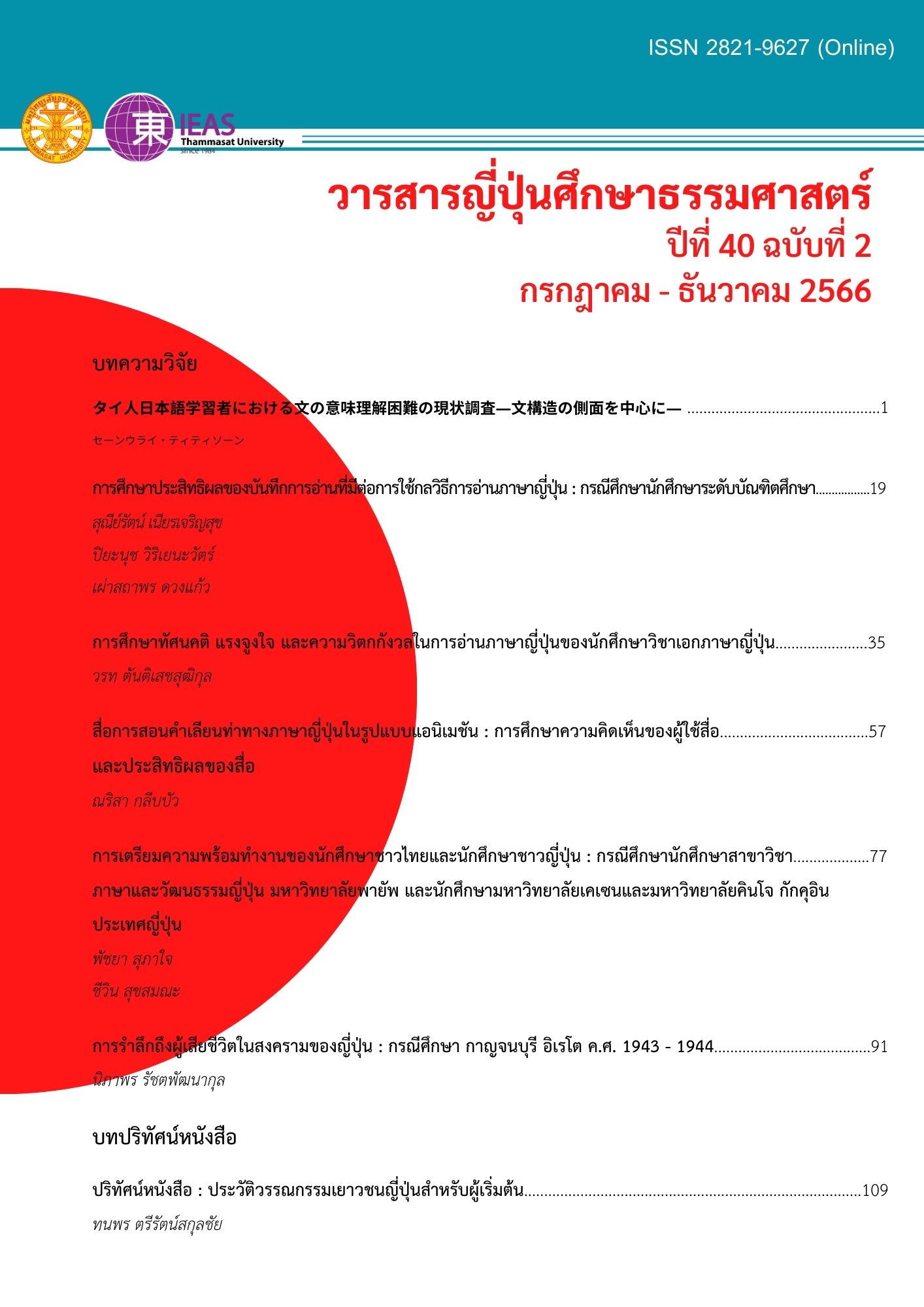สื่อการสอนคำเลียนท่าทางภาษาญี่ปุ่นในรูปแบบแอนิเมชัน : การศึกษาความคิดเห็นของผู้ใช้สื่อและประสิทธิผลของสื่อ
คำสำคัญ:
สื่อการสอนแอนิเมชัน, คำเลียนท่าทางภาษาญี่ปุ่น, อิทธิพลของภาษาไทย, บริบทการใช้บทคัดย่อ
งานวิจัยนี้มีวัตถุประสงค์คือเพื่อศึกษาเรื่องการผลิตสื่อการสอนคำเลียนท่าทางรูปแบบแอนิเมชัน ผู้วิจัยได้จัดทำสื่อ และสำรวจความคิดเห็นของผู้เรียนภาษาญี่ปุ่นที่ได้ทดลองใช้สื่อ และประสิทธิผลของสื่อกลุ่มเป้าหมายได้แก่ ผู้เรียนและผู้สอนภาษาญี่ปุ่นที่มีความสนใจในการศึกษาเรื่องคำเลียนท่าทาง โดยแบ่งเป็นการเก็บข้อมูลความคิดเห็นที่มีต่อสื่อการสอนภาษาญี่ปุ่นปัจจุบันและคำเลียนท่าทางในภาษาญี่ปุ่น ผู้ตอบแบบสอบถามรวม 40 คน ได้แก่ ผู้เรียนจำนวน 37 คน ผู้สอน 3 คน และการเก็บข้อมูลโดยใช้แบบทดสอบเพื่อศึกษาประสิทธิผลก่อนและหลังทดลองใช้สื่อการสอน มีผู้เรียนให้ความร่วมมือจำนวน 6 คน
ผลการวิจัยพบว่า หลังจากใช้สื่อการสอนที่ผู้วิจัยจัดทำขึ้น ผู้เรียนสามารถทำแบบทดสอบเรื่องคำเลียนท่าทางได้ดีขึ้นร้อยละ 5-30 อย่างไรก็ตาม มีคำเลียนท่าทางบางคำที่ผู้เรียนเลือกใช้ผิดหลังจากที่ใช้สื่อการสอน แม้ว่าก่อนใช้สื่อการสอน ผู้เรียนจะเลือกตอบได้ถูกต้อง หรือคำเลียนท่าทางบางคำที่ผู้เรียนยังคงเลือกตอบผิดเช่นเดียวกับตอนก่อนใช้สื่อการสอน สาเหตุที่ผู้เรียนเลือกตอบผิดมาจากอิทธิพลของภาษาไทย และความไม่ชัดเจนของบริบทการใช้ที่ปรากฏในสื่อการสอน ดังนั้นในการผลิตสื่อการสอน จึงควรเพิ่มความระมัดระวังในสองประเด็นดังกล่าว เพื่อผู้เรียนจะได้เข้าใจวิธีการใช้คำเลียนท่าทางได้อย่างถูกต้องมากขึ้น
Downloads
เอกสารอ้างอิง
ศุกิจ รชตะเกษม. (2550). การศึกษารูปคำและความหมายของคำบอกอาการและสภาพในภาษาญี่ปุ่น[วิทยานิพนธ์ปริญญาศิลปศาสตร์มหาบัณฑิต, มหาวิทยาลัยธรรมศาสตร์]. Thammasat University Digital Collections (TUDC). https://digital.library.tu.ac.th/tu_dc/frontend/Info/item/dc:111310
สุณีย์รัตน์ เนียรเจริญสุข. (2564). การวิเคราะห์ข้อผิดในงานเขียนภาษาญี่ปุ่นของผู้เรียนชาวไทยชั้นต้น. วารสารศิลปศาสตร์ มหาวิทยาลัยธรรมศาสตร์, 21(2), 1–29. https://doi.org/10.14456/lartstu.2021.18
Keller, J. M. (1983). Motivational Design of Instruction. In Charles M. Reigeluth (Ed.), Instruction-Design Theories and Models: An Overview of their Current Status (pp. 383-384). Routledge.
石田敏子. (1995). 『日本語教授法改訂新版』.大修館書店.
窪薗晴夫編. (2019). 『オノマトペの謎 -ピカチュウからモフモフまで-』. 岩波書店.
国際交流基金. (2023).「海外の日本語教育の現状 2021年度 海外日本語教育機関調査より」. https://www.jpf.go.jp/j/project/japanese/survey/result/dl/survey2021/all.pdf
杉浦正利・岩崎良美.(2003). 「日本語学習者のための擬音語・擬態語学習用マルチメディアCALL教材の改善に向けて」. 『国際開発研究フォーラム』, 23, 1-20.
前田安里沙、上間大生、白水奈々重、松下光範. (2015).「日本語学習者と対象としたオノマトペ学習のためのディジタル絵本システム」. 『人工知能学会論文誌』, 30, 204-215.
三上京子. (2007). 『日本語オノマトペとその教育」早稲田大学大学院日本学教育研究科, 2006年度博士論文.
西郡二郎、王堂. (2015). 「マルチメディア教材『きらきらオノマトペ』の開発とWEB公開について」.『人文学報』, 503, 39-60.
ดาวน์โหลด
เผยแพร่แล้ว
ฉบับ
ประเภทบทความ
สัญญาอนุญาต
ลิขสิทธิ์ (c) 2023 วารสารญี่ปุ่นศึกษาธรรมศาสตร์

อนุญาตภายใต้เงื่อนไข Creative Commons Attribution-NonCommercial-NoDerivatives 4.0 International License.




